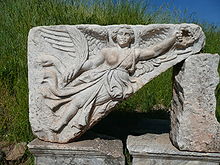
Nike (mythology)
Personification of victory in Greek mythology / From Wikipedia, the free encyclopedia
Dear Wikiwand AI, let's keep it short by simply answering these key questions:
Can you list the top facts and stats about Nike (mythology)?
Summarize this article for a 10 years old
In Greek mythology, Nike (/ˈnaɪki/ ⓘ; Ancient Greek: Νίκη, lit. 'victory', ancient: [nǐː.kɛː], modern: [ˈni.ci]) was a goddess who personified victory in any field including art, music, war, and athletics.[1] She is often portrayed in Greek art as Winged Victory in the motion of flight;[2] however, she can also appear without wings as "Wingless Victory"[3] when she is being portrayed as an attribute of another deity such as Athena.[4] In Greek literature Nike is described as both an attribute and attendant to the gods Zeus and Athena.[5] Nike gained this honored role beside Zeus during the Titanomachy where she was one of the first gods to offer her allegiance to Zeus.[6] At Athens, Nike became a servant to Athena as well as an attribute of her due to the prominent status Athena held in her patron city. The fusion of the two goddesses at Athens has contributed to the ambiguity surrounding Nike's origins. It is unclear whether she originated from a character trait of the Greek goddess Athena or has always existed as an independent deity.[7] Her origin story in Greek mythology is also slightly ambiguous, with the Theogony claiming Nike to be the daughter of Styx and Pallas[8] while the Homeric Hymns describe Ares as being Nike's father.[9] Her Roman equivalent was Victoria.
| Nike | |
|---|---|
Goddess of victory | |
 Stone carving of the goddess Nike at the ruins of the ancient city of Ephesus | |
| Abode | Mount Olympus |
| Symbol | golden sandals, wings, wreaths |
| Personal information | |
| Parents | Pallas and Styx |
| Siblings | Kratos, Bia, Zelus and Scylla, Fontes (Fountains), Lacus (Lakes) |